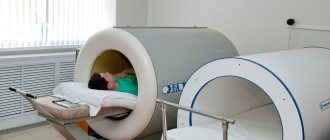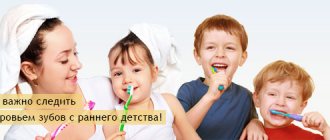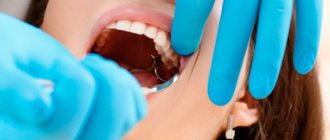Primary teeth are necessary so that, under the influence of occlusal load, a sufficient amount and volume of bone tissue is formed. Otherwise, permanent teeth simply would not be able to take root in the gums. Normally, a child's teeth are replaced in a certain order. As a result, the primary bite is replaced by a permanent one without pathologies.
Removal (extraction) of baby teeth only at first glance seems to be an absolutely simple procedure. If a baby tooth is lost long before a permanent tooth grows in its place, there is a risk of developing pathological changes in the bite. The decision to remove a child’s tooth must be made by a doctor.
Indications for tooth extraction in children
The absolute indications for the removal of baby teeth are:
- Neoplasms (cyst, phlegmon).
- Damage to the tooth with further development of a fistula.
- Severely advanced caries, as a result of which the crown of the tooth is completely destroyed.
- Chips and carious lesions in the crown of the tooth result in the formation of a sharp edge that injures the mucous membrane.
- Inflammation of the tissues adjacent to the tooth.
- The permanent tooth has already begun to erupt and the milk tooth interferes with it.
Application of anesthesia
If the tooth is very loose, then most likely you will not need pain relief, but the doctor may suggest topical anesthesia (spray or gel), as well as infiltration anesthesia (an injection with an anesthetic drug).
General anesthesia can be used:
- for children 1-4 years old;
- children with mental illness;
- with organic brain damage;
- if you are intolerant or allergic to local painkillers.
Baby teeth are very important for the formation of the bite, as well as the health of permanent teeth, so only a pediatric dentist at a dental clinic should decide on their premature removal.
Contraindications
It is not recommended to remove a child’s baby teeth in the following cases:
- Severe chronic conditions (heart defects, epilepsy, etc.).
- Inflammation in the oral cavity (stomatitis, gingivitis).
- Problems with blood clotting.
- Infectious diseases in the acute phase (ARVI, influenza, scarlet fever, chickenpox, etc.).
If there are contraindications, tooth extraction can be dangerous. But not all contraindications are absolute. For example, if the baby has an inflammatory process or an infectious disease, the tooth can be removed after treatment. The final decision about the procedure will be made by the dentist.
How to remove a tooth without damaging the child’s psyche?
How to extract a baby tooth from a struggling and crying baby is a very pressing problem. Much depends on the professionalism of the doctor and the attitude of the parents. A good specialist will remove the tooth quickly and painlessly. The task of parents is not to be afraid themselves and not to groom their child with oohs and aahs. The child, seeing your fuss, will instantly decide that something terrible is about to happen. Try to give him examples of other, more flexible children, or play on the desire to be bolder than the rest of his peers. And, of course, your presence in the dental office with your child is simply necessary.
Baby teeth play an important role in the formation of permanent occlusion; the health of molars depends on them. Therefore, removing them prematurely can only be done as a last resort. Only parents are able to protect their child from such troubles by regularly attending preventive examinations and monitoring the child’s compliance with the rules of oral hygiene.
Removal without pain
In pediatric dentistry, it is very important to ensure the child’s comfort during the tooth extraction procedure. This applies to all stages of treatment. To prevent the baby from being afraid, double anesthesia is used:
- Anesthetic gel. It is necessary to reduce the sensitivity of the gums and prepare for further anesthesia.
- Injection anesthesia. After the gel begins to take effect, the nurse will inject an anesthetic into the gum. Thanks to the action of the gel, the child does not feel pain from the injection.
Many drugs for local anesthesia, which are used to anesthetize tooth extraction, are strong allergens. In order to exclude the possibility of an allergy, the child is given a skin test.
How to extract a baby tooth from a child at home
So, we come to the most age-old question for many parents. And the answer to it is ambiguous. On the one hand, when a child’s baby tooth becomes loose, it usually falls out spontaneously, without causing pain or discomfort to the baby. On the other hand, if parents are so eager to take an active part in this process, then they should remember that:
- Children should not be allowed to chew on solid food: apples, carrots, crackers. This can damage the gum tissue.
- You should not try to remove a tooth when the child is crying and resisting. This will cause psychological trauma to your child.
- You cannot remove a tooth using improvised, non-sterile means. You can get an infection in your mouth.
- You cannot put pressure on the tooth or tilt it. This will cause pain to the child and damage the gums.
In addition, risks such as incomplete tooth extraction (when fragments remain in the gum), root fracture, injury to neighboring teeth and bone tissue, damage to the nerve and gums - when removing a tooth at home, increase many times over. In this case, you, as a non-specialist, cannot guarantee that everything will go smoothly and safely.
Therefore, do not waste your time on barbaric and long-outdated methods of removing baby teeth with unpredictable consequences: save your nerves and the health of your child! Make an appointment with a pediatric dentist, where, under sterile conditions, a knowledgeable, experienced doctor, in a cozy office, while showing cartoons, will quickly and painlessly remove the desired baby tooth.
Features of milk teeth removal
Milk teeth have their own characteristics:
- Thin alveolar walls.
- Weak, poorly defined neck.
- Divergence of roots in different directions.
To remove teeth, forceps with a slight fixation are used. The doctor grabs the crown with forceps, turns the tooth inside out and removes it from the socket. After this, the hole must be carefully inspected. Due to the structural features of baby teeth, there is a risk that part of the root or crown will remain in the socket. If everything is normal and there are no fragments in the hole, a sterile swab will be placed on the child’s wound. This helps stop bleeding faster and protects the wound.
The extraction procedure is quick. Thanks to double anesthesia, the baby does not feel pain at all. Removal is comfortable, without pain and fear.
Causes of loss of baby teeth
As a rule, at the age of 5, a child’s first milk tooth begins to loosen. This is an absolutely natural, physiological process that happens to every child: the root of a baby tooth dissolves, the tooth begins to be held in place only by the gums, gradually loosening and eventually falling out. However, if the tooth fell out much earlier, this situation can no longer be considered normal. Baby teeth fall out prematurely due to:
- Tooth injuries
- Vitamin deficiency
- Rakhita
- Diabetes
- some genetic diseases
In most cases, these diseases can be treated, the main thing is to seek medical help in time.
If a tooth falls out a year or more ahead of schedule, this can lead to improper development of the bite and slow jaw growth. In this case, long-term orthodontic treatment will be required.
In addition, parents should pay attention to the following points:
Long process of falling out
If a child's baby tooth becomes loose for a long time but does not fall out, it can cause discomfort to the child, preventing him from eating and speaking. The gums around the tooth may become inflamed and painful.
Deterioration of the child's well-being
If a child has a loose tooth and, as a result, the temperature rises, loss of appetite, nausea and vomiting occur - first of all, seek advice from a pediatrician, and secondly - from a dentist.
Care after removal
In order for the wound to heal normally, you need to follow the recommendations for caring for your teeth after extraction. An infection can easily penetrate through an unhealed wound, which means that without care there is a risk of developing inflammation.
Caring for your child’s oral cavity is very simple:
- Immediately after removal, it is important to prevent the blood clot from being washed out of the socket. Therefore, the child should not eat or drink anything.
- The wound should be protected as much as possible from the risk of infection. You can't touch it with your hands. You need to make sure that the baby does not touch the hole. Penetration of infection can lead to the development of inflammation, suppuration and other complications.
- The first three days you need to do mouth baths. You can use medications that your surgeon recommends. Suitable decoctions of herbs with antiseptic and anti-inflammatory properties - sage, chamomile.
- The child’s diet should be monitored for the first five days. You should not eat solid food, cold and hot drinks, or confectionery.
If you follow these simple rules, a child almost never experiences complications after the removal of a baby tooth. In case of infection, you should immediately show the child to a doctor. You should come for examination if the following symptoms appear:
- Continuous bleeding. After removal of a dental unit, the wound may bleed for several hours. If the bleeding does not stop, you should consult a doctor.
- Bad breath. It may be a sign of developing inflammation or suppuration. The inflammatory process quickly spreads to other tissues, which can cause serious complications.
- Fever. Speaks of infection or inflammatory process. Immediately after surgery, your temperature may rise slightly. This is often due to the stress that the child experiences in the dental chair. If the temperature persists for a long time or rises during the healing process, you cannot delay a visit to the dental clinic.
Is it necessary to treat minor caries in baby teeth?
So, we found out that the consequence of premature tooth extraction can be a disruption in the physical and emotional development of the child. But it is important to understand that even if you notice small caries on your baby’s teeth, you should consult a dentist. An untreated baby tooth can cause problems such as:
- Defective rudiment of molars. A diseased milk tooth can infect with caries the germ of the permanent tooth being formed underneath it. If the rudiment is damaged, there is a high risk of developing a defective tooth or its absence.
- Gastrointestinal diseases. It is teeth affected by caries that cause many somatic diseases of the gastrointestinal tract. Gastritis, duodenitis, gastric and duodenal ulcers, pancreatitis, dyspepsia, pancreatitis and other unpleasant diseases often develop against the background of damaged teeth.
- Development of diseases of the ears, nose and throat. Few parents know that caries provokes chronic runny nose, tonsillitis, sinusitis, inflammation of the tonsils and other respiratory diseases.
- Bad breath. Many parents wonder why their child has bad breath. The cause of the smell, as a rule, is precisely caries, invisible to the inexperienced eye. The baby begins to develop complexes and problems with communication appear.
- Pulpitis. Untreated caries will eventually transform into pulpitis, which means the child will suffer from pain and insomnia and will have to undergo painful treatment from a doctor.
How does removing baby teeth affect your bite?
Removing baby teeth can be dangerous for the bite if the permanent teeth have not yet begun to emerge. The prolonged absence of a dental unit leads to the fact that neighboring ones begin to move, filling the empty space. When permanent teeth begin to emerge, they run out of space. This leads to the development of various bite defects.
When removal cannot be avoided, it is recommended to install special artificial crowns. This way you can avoid tooth movement and changes in your bite.
In addition to the risk of developing malocclusion, early removal of baby teeth may have other consequences:
- Articulation impairment. Because of this, speech defects often form, which can become a barrier to communication with others. Communication with peers is very important for a child. Problems due to speech defects can be a harbinger of psychological disorders.
- Digestive problems. Due to the lack of teeth, chewing becomes difficult and the process of processing food in the oral cavity is disrupted. Chewing is an important step in the digestion process. Its violation can lead to the development of gastrointestinal diseases.
You cannot remove baby teeth yourself, even if they are mobile. Extraction is a surgical procedure. An experienced specialist should remove teeth.
The Zuub.rf clinic has a children's department. Pediatric dentists and surgeons work here. The operation will be comfortable and completely safe for your baby.
What to do if you had to remove several baby teeth?
If premature removal of a baby tooth is inevitable in a child, then dentures are necessary. Most often these are removable plates with an artificial tooth. For large losses, doctors install crowns made of plastic or metal. This is necessary in order to prevent displacement of the dentition. And then new teeth will grow in the right place.
Tooth extraction: complications
Sometimes complications can occur after tooth extraction. What parents should pay attention to:
- if the baby has unbearable and prolonged pain;
- bleeding does not stop, the blood is bright scarlet;
- the child has severe swelling, which makes it difficult to swallow;
- the baby complains of immobility (numbness) of the jaw for more than 2 days;
- temperature above 38ºС.
If you notice that your child feels unwell after tooth extraction, contact a specialist immediately!
Removal of a permanent tooth in a child is always done only for emergency reasons, when other methods of treatment and restoration cannot be performed. Take care of the health of your children's teeth!











